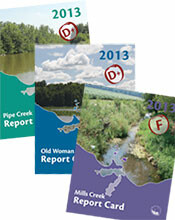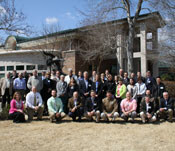Environment Canada Great Lakes diagram workshop
 In late February, Caroline Wicks and Brianne Walsh traveled to Oakville, Ontario for a workshop with Environment Canada and W.F. Baird & Associates to develop graphics for the Great Lakes Integrated Nearshore Framework. The Nearshore Framework will bring consistency to the assessment of ecosystem health in the nearshore and provide a model for governance, priority setting, and action planning in the Great Lakes Watershed. IAN was tasked with the creation of several diagrams and base maps that can be used to communicate the basic science, key issues of concern, and linkages between the ecosystem and humans within the Great Lakes watershed. These diagrams will be available via the Nearshore Framework, which is slated to be complete in 2016.
In late February, Caroline Wicks and Brianne Walsh traveled to Oakville, Ontario for a workshop with Environment Canada and W.F. Baird & Associates to develop graphics for the Great Lakes Integrated Nearshore Framework. The Nearshore Framework will bring consistency to the assessment of ecosystem health in the nearshore and provide a model for governance, priority setting, and action planning in the Great Lakes Watershed. IAN was tasked with the creation of several diagrams and base maps that can be used to communicate the basic science, key issues of concern, and linkages between the ecosystem and humans within the Great Lakes watershed. These diagrams will be available via the Nearshore Framework, which is slated to be complete in 2016.
2013 Firelands Coastal Tributaries Report Cards Released
 The aim of these three report cards is to provide a transparent, timely, and geographically detailed assessment of the watershed health for Old Woman Creek, Pipe Creek, and Mills Creek in 2013. This is the second year of the Old Woman Creek and Pipe Creek Report Cards, and the first year of the Mills Creek Report Card. All three creeks are located on the south-central shore of Lake Erie, and flow from south to north. While these streams are freshwater, they do include an estuarine section, where water is exchanged with Lake Erie. This year's report card analysis and production was done by the Erie Soil and Water Conservation District. In 2013, both Old Woman Creek and Pipe Creek grades declined. Old Woman Creek health scored a D+ in 2013, down from a C in 2012. Pipe Creek health also scored a D+ in 2013, down from a C- in 2012. Mills Creek health scored an F in 2013. Detailed methods and results are available from the Firelands Coastal Tributaries Watershed Program.
The aim of these three report cards is to provide a transparent, timely, and geographically detailed assessment of the watershed health for Old Woman Creek, Pipe Creek, and Mills Creek in 2013. This is the second year of the Old Woman Creek and Pipe Creek Report Cards, and the first year of the Mills Creek Report Card. All three creeks are located on the south-central shore of Lake Erie, and flow from south to north. While these streams are freshwater, they do include an estuarine section, where water is exchanged with Lake Erie. This year's report card analysis and production was done by the Erie Soil and Water Conservation District. In 2013, both Old Woman Creek and Pipe Creek grades declined. Old Woman Creek health scored a D+ in 2013, down from a C in 2012. Pipe Creek health also scored a D+ in 2013, down from a C- in 2012. Mills Creek health scored an F in 2013. Detailed methods and results are available from the Firelands Coastal Tributaries Watershed Program.
Third Mississippi River Report Card workshop held in Memphis, Tennessee
 IAN staff traveled to Memphis, Tennessee for the third of six sub-basin workshops for the Mississippi River Report Card project. This workshop focused on the Lower Mississippi River Basin, which represents the downstream portion of the entire Mississippi River watershed, including the Upper Mississippi, Ohio, Missouri, Arkansas, Red, and White Rivers. The two-day workshop brought together experts from natural resource science and management, engineering, and economic sectors. A key feature of this basin is an underground aquifer that supplies drinking water to millions of people. It stretches between Memphis, TN, and Greenville, MS. Workshop participants helped determine indicators that would be used to address the six goals (flood risk, transportation, ecosystems, economies, water supply, and recreation) of the Mississippi River report card. This report card is part of the America's Watershed Initiative.
IAN staff traveled to Memphis, Tennessee for the third of six sub-basin workshops for the Mississippi River Report Card project. This workshop focused on the Lower Mississippi River Basin, which represents the downstream portion of the entire Mississippi River watershed, including the Upper Mississippi, Ohio, Missouri, Arkansas, Red, and White Rivers. The two-day workshop brought together experts from natural resource science and management, engineering, and economic sectors. A key feature of this basin is an underground aquifer that supplies drinking water to millions of people. It stretches between Memphis, TN, and Greenville, MS. Workshop participants helped determine indicators that would be used to address the six goals (flood risk, transportation, ecosystems, economies, water supply, and recreation) of the Mississippi River report card. This report card is part of the America's Watershed Initiative.
IAN farewells Christina Lyerly and welcomes Vanessa Vargas
 Christina Lyerly has accepted a position at the Maryland Department of Environment, working on stormwater issues. She will dramatically reduce her daily commute and be able to work on issues close to her heart. Christina was able to complete the New Insights report before leaving and her assistance with the MADE Clear project and various other IAN projects will be missed. Vanessa Vargas recently joined IAN as a Science Communication Assistant. She recently obtained her Master's in Marine, Estuarine, and Environmental Science from the University of Maryland while working as a Graduate Research Assistant at the Institute of Marine and Environmental Technology in Baltimore. Vanessa hails from the Philippines where she obtained a Bachelor's and Master's degree from the University of the Philippines (UP). She worked as a Research Associate at the Harmful Algal Blooms (HABs) laboratory at the UP Marine Science Institute, focusing primarily on the microbial ecology and toxicity of Pyrodinium bahamense var compressum and other HABs species. Vanessa is an avid SCUBA diver and traveler. In her free time, she enjoys exploring new places and adventures, and studying movement through the Martial Arts.
Christina Lyerly has accepted a position at the Maryland Department of Environment, working on stormwater issues. She will dramatically reduce her daily commute and be able to work on issues close to her heart. Christina was able to complete the New Insights report before leaving and her assistance with the MADE Clear project and various other IAN projects will be missed. Vanessa Vargas recently joined IAN as a Science Communication Assistant. She recently obtained her Master's in Marine, Estuarine, and Environmental Science from the University of Maryland while working as a Graduate Research Assistant at the Institute of Marine and Environmental Technology in Baltimore. Vanessa hails from the Philippines where she obtained a Bachelor's and Master's degree from the University of the Philippines (UP). She worked as a Research Associate at the Harmful Algal Blooms (HABs) laboratory at the UP Marine Science Institute, focusing primarily on the microbial ecology and toxicity of Pyrodinium bahamense var compressum and other HABs species. Vanessa is an avid SCUBA diver and traveler. In her free time, she enjoys exploring new places and adventures, and studying movement through the Martial Arts.

